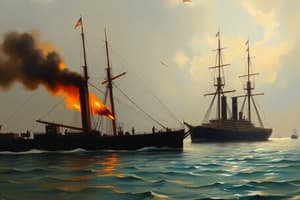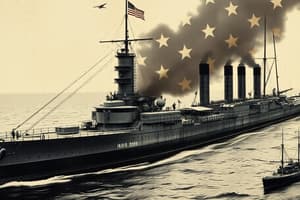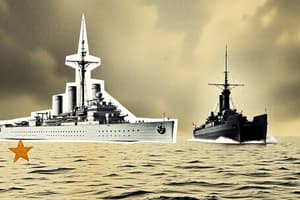Podcast
Questions and Answers
Which factor MOST significantly hindered the CSS Virginia's operational capabilities throughout the Battle of Hampton Roads?
Which factor MOST significantly hindered the CSS Virginia's operational capabilities throughout the Battle of Hampton Roads?
- The inexperience of the Confederate naval crews, which affected the ship's maneuverability and combat effectiveness.
- Its deep draft of 22 feet, which restricted its movement in the shallow waters of the area. (correct)
- Frequent mechanical failures of the jury-rigged engines, causing delays and limiting its engagement range.
- The limited supply of iron plating available to the Confederacy, restricting the armor's effectiveness.
Which strategic imperative MOST influenced Commodore Charles McCauley's decision to burn the Gosport Navy Yard?
Which strategic imperative MOST influenced Commodore Charles McCauley's decision to burn the Gosport Navy Yard?
- To quickly evacuate Union personnel and resources in anticipation of an imminent Confederate attack.
- To ensure the destruction of advanced naval technologies that could benefit the Confederacy.
- To prevent the Union's war supplies and naval assets from falling into Confederate hands. (correct)
- To create a diversion that would allow Union forces to regroup and establish a stronger defensive position.
What was the MOST immediate strategic consequence of the battle's outcome regarding naval warfare?
What was the MOST immediate strategic consequence of the battle's outcome regarding naval warfare?
- The battle ushered in a new era of naval warfare, rendering wooden warships obsolete and spurring rapid development of ironclad technology. (correct)
- The battle demonstrated the decisive superiority of ironclad rams over traditional frigates, leading to their widespread adoption.
- The Union Navy immediately adopted ironclad technology as the standard for all new warships.
- The Confederate Navy gained unchallenged control of the American coastline, disrupting Union trade routes.
What critical design DIFFERENCE between the USS Monitor and CSS Virginia MOST affected their combat performance during their engagement?
What critical design DIFFERENCE between the USS Monitor and CSS Virginia MOST affected their combat performance during their engagement?
What critical logistical challenge MOST hampered the Confederate's ability to fully realize the potential of the CSS Virginia?
What critical logistical challenge MOST hampered the Confederate's ability to fully realize the potential of the CSS Virginia?
Which tactical decision during the first day of the Battle of Hampton Roads proved MOST decisive in shifting the immediate balance of power?
Which tactical decision during the first day of the Battle of Hampton Roads proved MOST decisive in shifting the immediate balance of power?
Which technological constraint MOST directly influenced the limited effectiveness of both the USS Monitor and CSS Virginia during their engagement?
Which technological constraint MOST directly influenced the limited effectiveness of both the USS Monitor and CSS Virginia during their engagement?
What strategic rationale BEST explains the Union's decision to prioritize the protection of the USS Minnesota during and after the battle?
What strategic rationale BEST explains the Union's decision to prioritize the protection of the USS Minnesota during and after the battle?
Which command decision MOST influenced the CSS Virginia's ultimate fate after the Battle of Hampton Roads?
Which command decision MOST influenced the CSS Virginia's ultimate fate after the Battle of Hampton Roads?
What was the primary factor that drove the Union's ironclad board to accelerate the construction of the USS Monitor?
What was the primary factor that drove the Union's ironclad board to accelerate the construction of the USS Monitor?
How did the technological advancements demonstrated during the battle impact subsequent naval doctrine?
How did the technological advancements demonstrated during the battle impact subsequent naval doctrine?
What IMMEDIATE impact did the Battle of Hampton Roads have on international perceptions of naval power?
What IMMEDIATE impact did the Battle of Hampton Roads have on international perceptions of naval power?
How did the limited freeboard of the USS Monitor MOST directly affect its operational effectiveness during the Battle of Hampton Roads?
How did the limited freeboard of the USS Monitor MOST directly affect its operational effectiveness during the Battle of Hampton Roads?
What was the MOST significant long-term implication of the battle regarding naval blockade strategies?
What was the MOST significant long-term implication of the battle regarding naval blockade strategies?
Which strategic advantage did the Union gain by retaining control of the Gosport Navy Yard, even after its partial destruction?
Which strategic advantage did the Union gain by retaining control of the Gosport Navy Yard, even after its partial destruction?
What critical deficiency in Confederate naval strategy was highlighted by the events following the Battle of Hampton Roads?
What critical deficiency in Confederate naval strategy was highlighted by the events following the Battle of Hampton Roads?
What fundamental challenge in naval architecture was exposed by the performance of both the USS Monitor and CSS Virginia?
What fundamental challenge in naval architecture was exposed by the performance of both the USS Monitor and CSS Virginia?
Which tactical innovation was MOST directly inspired by the outcome of the Battle of Hampton Roads?
Which tactical innovation was MOST directly inspired by the outcome of the Battle of Hampton Roads?
Which characteristic of naval warfare was MOST profoundly altered by the introduction of ironclad warships like the Monitor and Virginia?
Which characteristic of naval warfare was MOST profoundly altered by the introduction of ironclad warships like the Monitor and Virginia?
Considering the broader context of the American Civil War, what strategic goal did the CSS Virginia's mission at Hampton Roads MOST directly aim to achieve?
Considering the broader context of the American Civil War, what strategic goal did the CSS Virginia's mission at Hampton Roads MOST directly aim to achieve?
Flashcards
Gosport Navy Yard
Gosport Navy Yard
US Navy Yard, abandoned and burned by Union forces at the start of the Civil War to prevent Confederate capture of supplies.
CSS Virginia
CSS Virginia
A casemate ironclad ram, originally the USS Merrimack, rebuilt by the Confederacy.
USS Monitor
USS Monitor
Federal response to the CSS Virginia, featuring two 11-inch Dahlgren smoothbore cannons in a rotating turret.
Hampton Roads
Hampton Roads
Signup and view all the flashcards
USS Cumberland
USS Cumberland
Signup and view all the flashcards
USS Congress
USS Congress
Signup and view all the flashcards
Outcome of Monitor vs. Virginia
Outcome of Monitor vs. Virginia
Signup and view all the flashcards
Study Notes
- At the start of the war, Union forces abandoned the Gosport Navy Yard, known today as the Norfolk Navy Yard.
- Commodore Charles McCauley ordered the yard to be burnt to prevent war supplies from falling into Confederate hands, fearing an uprising.
- The burning was done hastily and proved inadequate.
- The USS Merrimack was at the yard for repairs and refitting when it was burned and scuttled.
- The Merrimack's hull was only damaged above the waterline.
- Confederates refloated the hull and began plans to transform the Merrimack.
- The burned-out vessel was converted into a casemate ironclad ram over nine months and renamed CSS Virginia.
- Iron plating protected everything above the waterline.
- The weight of the iron plating contributed to the vessel's deep draft of 22 feet.
- Limited iron supply and production capability slowed down the construction.
- As word spread of the Confederacy's plans for the Merrimack, the Federals established the ironclad board to counter this threat.
- Plans quickly became a reality with the rushed construction of the USS Monitor.
- The USS Monitor had a very low freeboard, with only around 18 inches of space between the waterline and the deck.
- Her primary armament was two 11-inch Dahlgren smoothbore cannons, located inside its rotating turret.
- The unfinished ironclad launched on 30 January 1862 from the New York Navy Yard.
The Battle: First Day
- On March 8, 1862, the CSS Virginia, accompanied by the CSS Beaufort and CSS Raleigh, sailed to Hampton Roads to break the Union blockade.
- CSS Virginia engaged and rammed the USS Cumberland, sinking it.
- A shot from USS Congress bounced off the thick armor of the Confederate ironclad.
- CSS Beaufort fired at Congress as the Confederate fleet approached.
- CSS Virginia fired broadside into Congress as they passed.
- The ram of Virginia hit the starboard side of the Cumberland, a sloop-of-war, and rammed it a second time.
- The Virginia and Congress exchanged fire until the Congress ran aground and was later burned.
- CSS Jamestown and CSS Patrick Henry, along with the Virginia, headed for the grounded USS Minnesota, but the Virginia could not get closer than a mile due to its deep draft.
- The Confederates slipped away from the crippled frigate after darkness came and moved off to Sewell's Point to await a new day.
The Battle: Second Day
- On the morning of March 9, 1862, the Virginia came out to finish the battle, heading towards the Minnesota.
- The Monitor appeared and opened fire, causing the CSS Jamestown and CSS Patrick Henry to retreat.
- The Virginia remained to face the Monitor.
- For four hours, the two ironclad ships circled each other and exchanged fire resulting in damage to both ships without either inflicting a fatal blow.
- The Monitor and Virginia withdrew from battle.
- The Monitor had orders to protect the Minnesota and stayed by her until tugs freed the Minnesota from the shoal later that night.
- The Virginia returned to the yard for repairs.
- The Virginia was unable to ascend the James River due to its deep draft and was eventually scuttled.
Studying That Suits You
Use AI to generate personalized quizzes and flashcards to suit your learning preferences.




